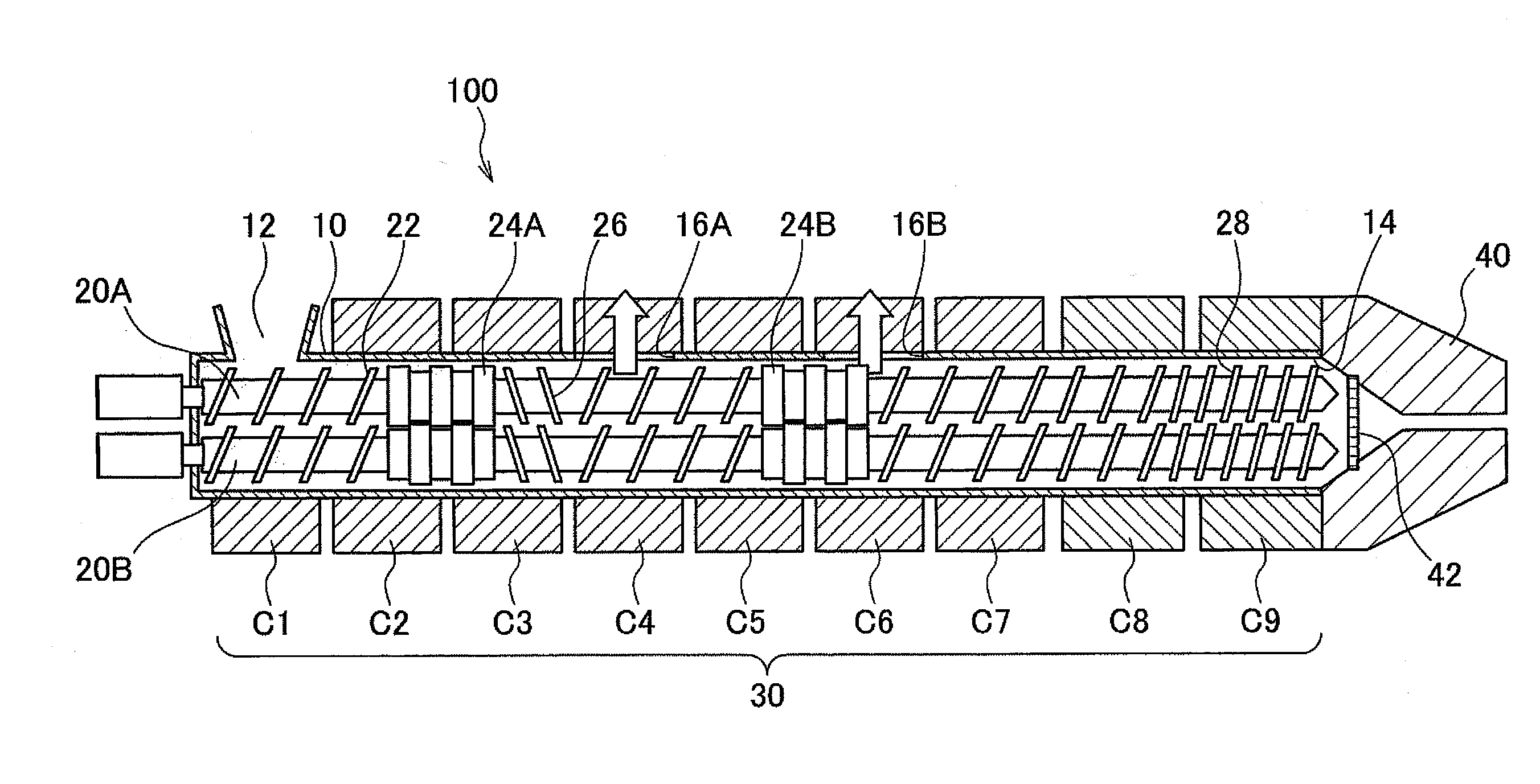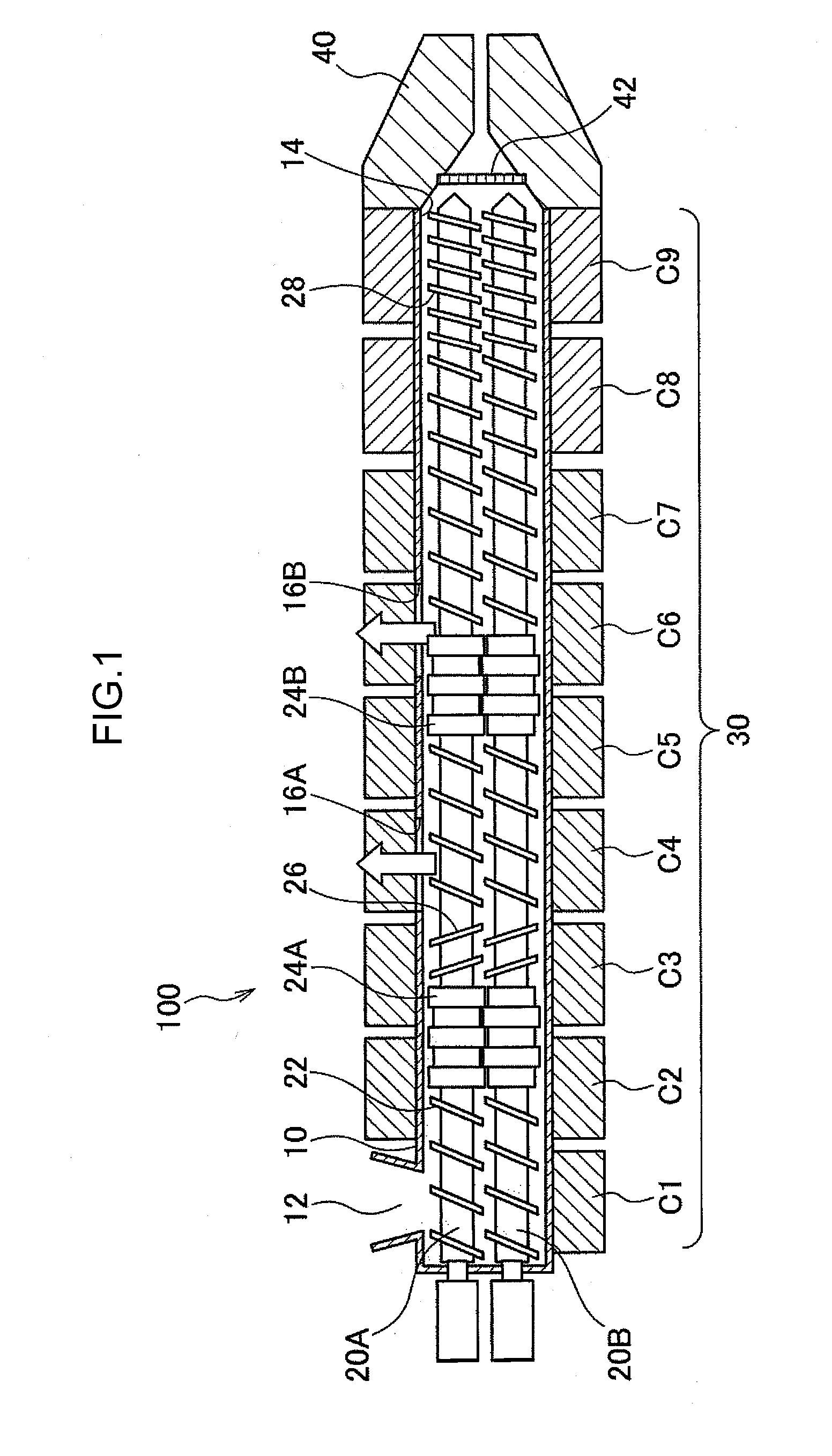Polyester film, method for producing the same, back sheet for solar cells, and solar cell module
a technology of polyester film and back sheet, which is applied in the field of polyester film, can solve the problems of detachment and discoloration of the filler layer, corrosion of the wiring, and functional deterioration of the photovoltaic cell
Inactive Publication Date: 2012-03-22
FUJIFILM CORP
View PDF0 Cites 47 Cited by
- Summary
- Abstract
- Description
- Claims
- Application Information
AI Technical Summary
Benefits of technology
[0091]Examples of the titanium compound include organic chelate titanium complexes, and generally, oxides, hydroxides, alkoxides, carboxylates, carbonates, oxalates and halides. According to the invention, an embodiment of using an organic chelate titanium complex is preferable, and to an extent of not impairing the effects of the invention, another titanium compound may be used in combination with the organic chelate titanium complex. Examples of the titanium compound include known compounds such as an alkyl titanate or a partial hydrolysate thereof, titanium acetate, and a titanyl oxalate compound. Specific examples include titanium alkoxides such as tetraethyl titanate, tetraisopropyl titanate, tetrabutyl titanate, tetra-n-propyl titanate, tetra-i-propyl titanate, tetra-n-butyl titanate, tetra-n-butyl titanate tetramer, tetra-t-butyl titanate, tetracyclohexyl titanate, tetraphenyl titanate, and tetrabenzyl titanate; titanium oxides obtainable by hydrolysis of titanium alkoxides; titanium-silicon or zirconium composite oxides obtainable by hydrolysis of mixtures of titanium alkoxides and silicon alkoxides or zirconium alkoxides; titanium acetate, titanium oxalate, potassium titanium oxalate, sodium titanium oxalate, potassium titanate, sodium titanate, titanic acid-aluminum hydroxide mixtures, titanium chloride, titanium chloride-aluminum chloride mixtures, and titanium acetylacetonate.
[0092]In the synthesis of a Ti-based polyester using such a titanium compound, for example, the methods described in Japanese Examined Patent Application (JP-B) No. 8-30119, Japanese Patent Nos. 2543624, 3335683, 3717380, 3897756, 3962226, 3979866, 3996871, 4000867, 4053837, 4127119, 4134710, 4159154, 4269704, and 4313538 can be applied.
[0093]Examples of the phosphorus compound include known compounds such as phosphoric acid, phosphorous acid or esters thereof, phosphonic acid compounds, phosphinic acid compounds, phosphonous acid compounds, and phosphinous acid compounds. Specific examples include orthophosphoric acid, dimethyl phosphate, trimethyl phosphate, diethyl phosphate, triethyl phosphate, dipropyl phosphate, tripropyl phosphate, dibutyl phosphate, tributyl phosphate, diamyl phosphate, triamyl phosphate, dihexyl phosphate, trihexyl phosphate, diphenyl phosphate, triphenyl phosphate; ethyl acid phosphate, dimethyl phosphite, trimethyl phosphite, diethyl phosphite, triethyl phosphite, dipropyl phosphite, tripropyl phosphite, dibutyl phosphite, tributyl phosphite, diphenyl phosphite, triphenyl phosphite, diamyl phosphite, triamyl phosphite, dihexyl phosphite, and trihexyl phosphite.
[0094]Furthermore, it is preferable not to incorporate any metal compound other than the titanium compound and the phosphorus compound. However, for an enhancement of the productivity of film, and for the purpose of lowering the volume-specific resistance value at the time of melting, a metal such as magnesium, calcium, lithium or manganese may be incorporated in an amount in the range of 100 ppm or less that is conventionally used, and the metal may be incorporated preferably in an amount in the range of 60 ppm or less, and even more preferably 50 ppm or less. In order to incorporate particles or various additives, in the case of using a method of using a master batch method or the like, antimony may be incorporated as a metal component other than the catalyst, and from the viewpoints of increasing hydrolysis resistance and weather resistance, the content of antimony relative to the total amount of the film can be adjusted to 30 ppm or less, in terms of the amount of antimony metal element, and preferably to 20 ppm or less.
[0095]A polyester film containing titanium and phosphorus in the amounts described above may be produced by mixing a polyester produced using a titanium compound as a catalyst and a polyester containing a phosphorus compound. In this case, a method in which a polyester containing a predetermined amount of a phosphorus compound is prepared as a master batch, and the polyester is mixed with a polyester produced using a titanium catalyst, is preferable. Examples of the method of preparing a master batch of a phosphorus compound include a method of performing polymerization using a germanium catalyst, a method of performing polymerization using a minimal amount of an antimony catalyst, and a method of adding the master batch by a process of melt extruding to a polyester produced using a titanium catalyst. Among them, it is particularly preferable to use a germanium catalyst.
[0096]The ratio of phosphorus element contained in the polyester film and titanium element derived from the catalyst, as a molar ratio (P / Ti), is preferably in the range of 1.0 to 20.0, and more preferably in the range of 5.0 to 15.0. When the ratio is in this range, weather resistance can be further enhanced.
Problems solved by technology
In a solar cell module, when water vapor, oxygen gas and the like infiltrate into the inside of the module, there is a risk that such infiltration may cause detachment and discoloration of the filler layers, corrosion of the wiring, functional deterioration of the photovoltaic cell, and the like.
On the other hand, a polyester film has a tendency to be susceptible to deterioration due to hydrolysis when the thickness increases.
However, in the above-described conventional method intended to improve hydrolysis resistance by a polymerization catalyst, it is not necessarily possible to secure the hydrolysis resistance that is requested for solar cell applications, and it is difficult to maintain excellent weather resistance of a PET film over a long period of time.
Also, in the method for producing a polyester sheet by melt extrusion under specific conditions, the effect of improving long-term hydrolysis resistance is not sufficient, and a further improvement is required in terms of the hydrolysis resistance demanded in solar cell applications.
Method used
the structure of the environmentally friendly knitted fabric provided by the present invention; figure 2 Flow chart of the yarn wrapping machine for environmentally friendly knitted fabrics and storage devices; image 3 Is the parameter map of the yarn covering machine
View moreImage
Smart Image Click on the blue labels to locate them in the text.
Smart ImageViewing Examples
Examples
Experimental program
Comparison scheme
Effect test
examples
[0259]Hereinafter, the invention will be more specifically described by way of Examples, but the invention is not intended to be limited to the following Examples as long as the main gist is maintained. In addition, the unit “parts” in the Examples is on a mass basis.
the structure of the environmentally friendly knitted fabric provided by the present invention; figure 2 Flow chart of the yarn wrapping machine for environmentally friendly knitted fabrics and storage devices; image 3 Is the parameter map of the yarn covering machine
Login to View More PUM
| Property | Measurement | Unit |
|---|---|---|
| Temperature | aaaaa | aaaaa |
| Temperature | aaaaa | aaaaa |
| Temperature | aaaaa | aaaaa |
Login to View More
Abstract
Provided is a method for producing a polyester film, including: subjecting a polyester raw material resin, which contains a titanium compound and has an intrinsic viscosity of from 0.71 to 1.00, to melt extrusion using a twin-screw extruder which includes a cylinder; two screws disposed inside the cylinder; and a kneading disk unit disposed in at least a portion of a region extending from a 10%-position to a 65%-position of screw length with respect to an upstream end of the screws in a resin extrusion direction as a starting point, at a maximum shear rate generated inside the twin-screw extruder of from 10 sec−1 to 2000 sec−1;forming an unstretched film by cooling and solidifying the melt extruded polyester resin on a cast roll; subjecting the unstretched film to biaxial stretching in a longitudinal direction and a lateral direction; and heat fixing the stretched film formed by biaxial stretching.
Description
CROSS-REFERENCE TO RELATED APPLICATION[0001]This application claims priority under 35 USC 119 from Japanese Patent Application No. 2010-210185, filed on Sep. 17, 2010, the disclosure of which is incorporated by reference herein.BACKGROUND OF THE INVENTION[0002]1. Field of the Invention[0003]The present invention relates to a polyester film, a method for producing the polyester film, a back sheet for solar cells, and a solar cell module.[0004]2. Description of the Related Art[0005]In recent years, as there has been a rise in concerns about environmental problems such as global warming, more attention has been paid to photovoltaic power generation as a source of clean energy, and various forms of solar cells have been developed. Such a solar cell is generally constructed from plural solar cell modules in which plural pieces of photovoltaic cells wired in series or in parallel are packaged into a unit.[0006]Solar cell modules are required to have high durability, weather resistance and...
Claims
the structure of the environmentally friendly knitted fabric provided by the present invention; figure 2 Flow chart of the yarn wrapping machine for environmentally friendly knitted fabrics and storage devices; image 3 Is the parameter map of the yarn covering machine
Login to View More Application Information
Patent Timeline
 Login to View More
Login to View More IPC IPC(8): B32B3/00C08G63/183B29C55/02H01L31/0216B29C47/00B29C48/08B29C48/305B29C48/37B29C48/40B29C48/54B29C48/55B29C48/57B29C48/693B29C48/91
CPCB29C47/0021Y10T428/24372B29C47/402B29C47/6056B29C47/686B29C47/767B29C47/8845B29C55/143B29C2947/92152B29C2947/92447B29C2947/92514B29C2947/92704B29C2947/92895B29C2947/92923B29K2067/00B29K2067/003C08G63/85C08J5/18C08J2367/02H01L31/0481Y02E10/50B29C47/6031B29C47/6037H01L31/049B29C47/364B29C2948/92704B29C48/08B29C48/37B29C48/402B29C48/54B29C48/55B29C48/57B29C48/693B29C48/767B29C48/91B29C48/914B29C48/917B29C2948/92152B29C2948/92447B29C2948/92514B29C2948/92895B29C2948/92923B29B7/483B29B7/489B29B7/72B29B7/826B29B7/845B29B7/86B29C48/40B29D7/01B29C55/10
Inventor SHI, ZEMINFUJITA, AKIHIDEYAMADA, AKIRA
Owner FUJIFILM CORP
Features
- R&D
- Intellectual Property
- Life Sciences
- Materials
- Tech Scout
Why Patsnap Eureka
- Unparalleled Data Quality
- Higher Quality Content
- 60% Fewer Hallucinations
Social media
Patsnap Eureka Blog
Learn More Browse by: Latest US Patents, China's latest patents, Technical Efficacy Thesaurus, Application Domain, Technology Topic, Popular Technical Reports.
© 2025 PatSnap. All rights reserved.Legal|Privacy policy|Modern Slavery Act Transparency Statement|Sitemap|About US| Contact US: help@patsnap.com



